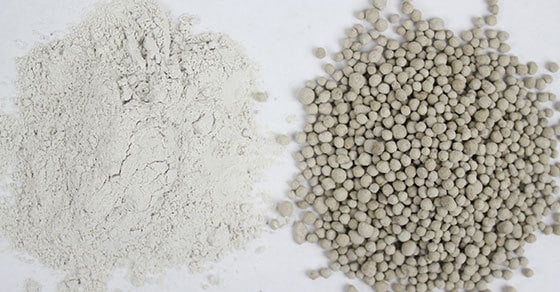Whether it is to prevent product loss, avoid health-related risks, or otherwise, managing fugitive dust is a key focus in nearly every industrial setting where bulk solids are handled. In fact, the crucial nature of dust suppression has caused it to evolve into an industry in itself, with a wide range of solutions available based on the unique requirements of the material at hand.
In cases where dust mitigation is of critical importance, be it for safety concerns, because of a high-value product, or otherwise, agglomeration provides a proactive, effective approach to dust suppression.
Why Dust Suppression is Critical
Dust from bulk solids has the potential to cause several issues in any setting; whether producing an end product, transporting a material to landfill, or preparing an intermediate material for downstream processing, typical dust-related issues include:
- Product loss
- Cross contamination
- Respiratory hazard
- Combustion risk
- Clogged equipment
- Reduced equipment life
- Increased downtime
- Hazardous work environment
- Contamination of surrounding areas
- Handling and flowability challenges
Each of these issues has the potential to place substantial cost and liability on a producer, making dust suppression essential in most operations.
Agglomeration for Dust Suppression
While many producers turn to collection and spray systems for dust suppression, these systems are largely reactive, managing dust only after it has been generated. Further, they are far from ideal when attempting to manage fugitive dust throughout the many stages and transfer points in a given material’s life cycle. A better approach to dust suppression is prevention.
Agglomeration is a particle size enlargement treatment that transforms dusty materials into granular products with significantly less dust. The approach can also provide a number of other benefits as well, including improved flowability, more uniform application/distribution, and enhanced product performance.
There are several types of agglomeration, each offering unique advantages and disadvantages. When it comes to dust suppression, one of several techniques may be employed, with the choice depending on the specific project goals and the level of dust suppression required.
Each of the following techniques falls under the non-pressure, or tumble growth agglomeration (also known as agitation agglomeration) category. This type of agglomeration relies on a tumbling motion, paired with a (most often) liquid binder to form granules.
A Note on Compaction
Compaction granulation is a pressure agglomeration technique that utilizes extreme pressure in a roll compactor to produce granules. Because it does not typically utilize a liquid binder, this technique is considered a dry process. Producers will often turn to compaction granulation as a solution to dust, because of the fact that it is a dry process and therefore avoids a drying step, offering energy savings. However, compaction requires a higher capital investment and is far from ideal for minimizing dust.
Granules produced via compaction granulation are irregular particles with jagged edges. As material is handled and transferred, these edges rub together and degrade, causing attrition and dust generation. Additional steps can be taken to reduce the potential for attrition, but this increases operating, and in some cases, capital costs, negating the initial energy savings.
Conditioning
Conditioning describes the dust wetting process, or the act of combining a liquid binder (or water) with a powdery material in order to roughly agglomerate it.
Conditioning offers a low-cost, efficient option for dust suppression by wetting the dust, and in many cases, producing small, typically non-uniform granules. This technique is often employed when a dusty material must be brought to landfill; by conditioning the material, load out, transportation, and application becomes much easier and the risk of material becoming wind blown is mitigated. For the same reasons, the technique is also frequently used as a way to mitigate dust issues in production settings.
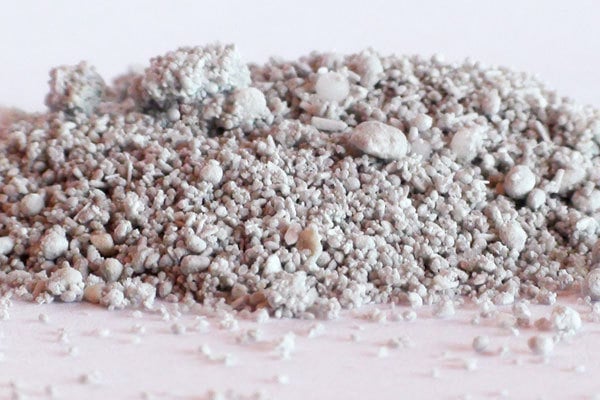
Glass batch that has been conditioned in a pin mixer
What the Conditioning Process Looks Like
Conditioning is typically carried out using a pin mixer or pugmill mixer, both of which are continuous, horizontal industrial mixers. While the mechanical action within the mixers differs, both are capable of combining multiple liquid and solid feed components into a homogeneous mixture for minimized dust.
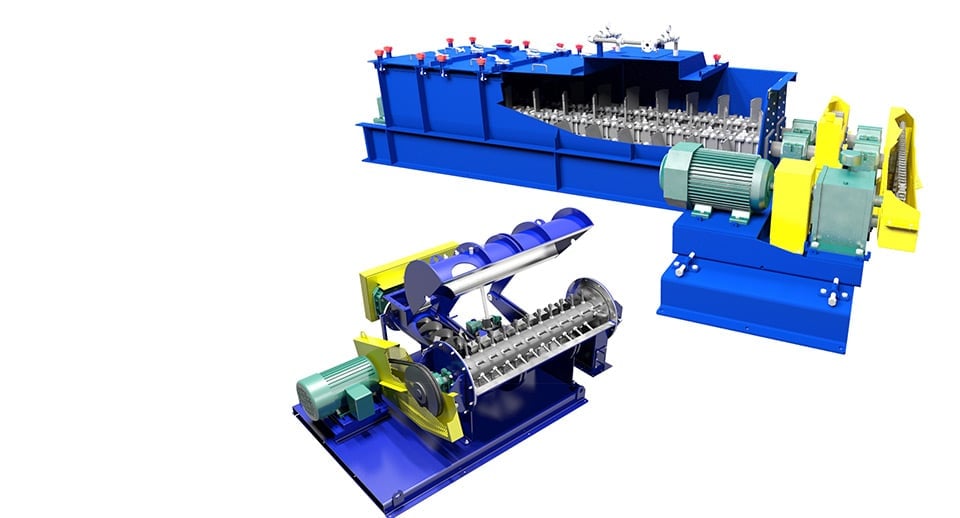
3D Models of a FEECO Pugmill Mixer (top) and pin mixer (bottom)
The choice between the two mixers is dependent on the characteristics of the material in combination with process goals.
A drying step may or may not be utilized.
Pelletizing
The term “pelletizing” is often used to describe all manner of agitation agglomeration processes. Here, the term is used to refer to the process of producing enlarged, uniform particles via tumble growth agglomeration in a pin mixer, disc pelletizer (pan granulator), rotary drum, or combination thereof.
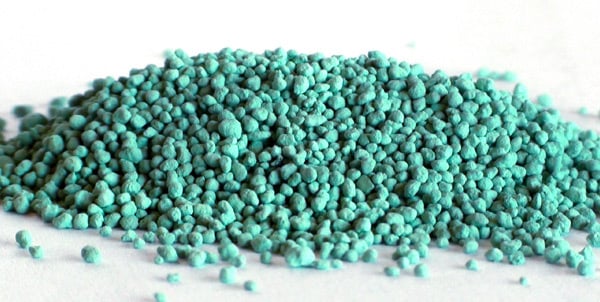
Paint pigment that has been pelletized in a pin mixer
Most often, the term is used to describe the pin mixer-disc pelletizer combination, which produces a high range of on-size, refined spherical pellets.
Unlike conditioning, which generally focuses solely on dust suppression, pelletizing focuses on producing granules of an intended size, often along with other specified attributes.
What the Pelletizing Process Looks Like
As mentioned, several devices may be employed in a pelletizing plant. Combined with the unique nature of every material, the process chosen is highly variable, and always dependent on the material characteristics and the goals of pelletizing.
In the pin mixer-disc pelletizer setup, the pin mixer serves as a preconditioning step, homogeneously mixing liquid and solid feed components into a uniform mixture for feeding the disc pelletizer. The mixer may also serve to produce seed pellets for further growth on the disc pelletizer.
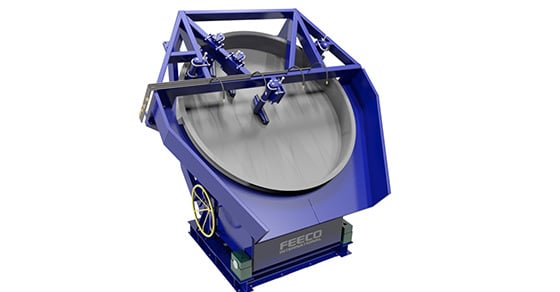
3D Model of a FEECO Pan Granulator (Disc Pelletizer)
Since a liquid binder is utilized in this process, a drying step is typically necessary.
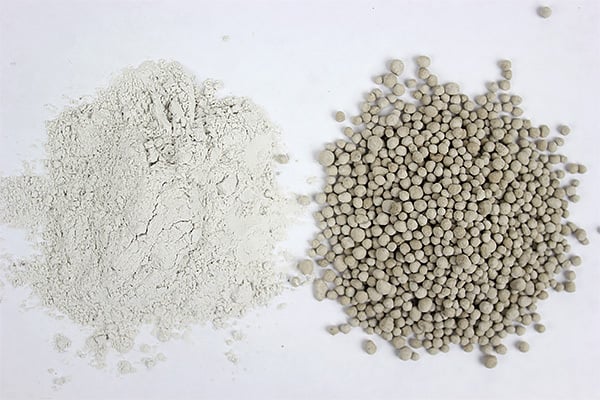
Raw limestone powder before and after pelletizing using the pin mixer-disc pelletizer setup
Coating for Dust Suppression
Unlike the aforementioned techniques, coating itself is not an agglomeration process. However, it further reduces the potential for dust when working with agglomerates.
While granular products are generally much less dusty than powders, dust generation can still occur for several reasons; among them, an inferior granule was produced (low crush strength), a material is hygroscopic, particle-to-particle contact issues exist, and more.
Coating offers a solution to dusty granules by creating a protective barrier between the granule and the environment. Depending on the material and the coating chosen, this barrier may discourage dust formation in a variety of ways.
What the Coating Process Looks Like
Many devices are available on the market for coating granular products. When a premium product is sought, FEECO recommends a coating drum, as this provides the most uniform and reliable results.
In this scenario, material is fed into a rotating drum, and a carefully designed spray system distributes the coating agent onto the bed of materials. The tumbling and rolling action that occurs in the bed ensures an even distribution of coating.
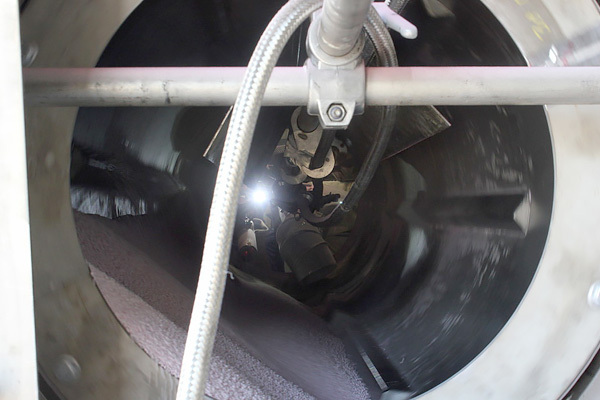
Interior of a coating drum in the FEECO Innovation Center
Choosing the Right Approach to Dust Suppression
While the economics and intention of dust suppression will largely guide the method chosen, testing is often a critical component in determining the best approach, particularly when targeting specific particle characteristics.
The FEECO Innovation Center is a state-of-the-art testing facility designed to test various methods and configurations of agglomeration and coating processes to evaluate the most suitable option for the goals at hand – dust suppression included.
Various configurations can be tested at both batch and pilot scale to identify the best process approach for the job and gather the data necessary for scale-up. Testing can be conducted on a single piece of equipment, or as a continuous process loop integrating multiple steps.
Conclusion
Dust suppression is essential to avoiding product loss, keeping employees safe, and so much more. While an array of dust suppression systems are available, when managing dust is a top priority, the best approach is prevention.
Techniques such as conditioning, pelletizing, and coating offer a superior level of dust suppression, helping to prevent it from the start. Depending on the goals of the operation, many configurations may be suitable, and as such, testing is often a key step in developing an efficient and effective approach to dust suppression.
FEECO is the global leader of agitation agglomeration equipment and systems, including all those mentioned here. All equipment is backed by comprehensive testing in our Innovation Center to engineer the most optimal processing solution possible. For more information on our testing programs or custom equipment, contact us today!



